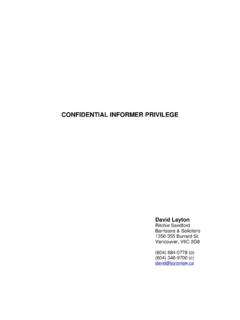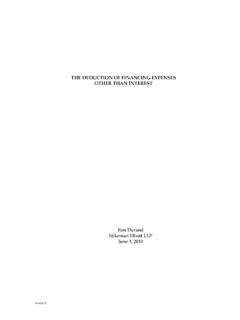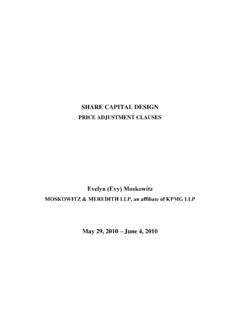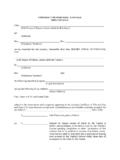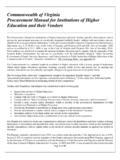Transcription of PURCHASE AND SALE OF A BUSINESS - SHARE …
1 TAX LAW FOR LAWYERS PURCHASE AND SALE OF A BUSINESS - SHARE transactions INCLUDING TAX ISSUES IN DOCUMENTATION Douglas A. Cannon Mario Abrioux McCarthy T trault LLP May 2010 TABLE OF CONTENTS PART ONE: TAX ISSUES Basic Principles A. Time of Disposition 1 B. Nature of the Gain 2 Preparing the Target Corporation A. Safe Income Dividends 3 B. Capital Dividends 6 C. Sale of Division 6 D. Inside vs. Outside Basis 10 E. Taxable Preferred shares 11 F. Dividend Tax Credit Rules 13 PURCHASE Price Planning A. Capital Gains Reserve 15 B. Earnout Provisions 16 C. Holdbacks/Adjustments/Warranties 17 D. Retiring Allowances/Consulting Fees 18 E. Restrictive Covenants 19 Financing the SHARE PURCHASE A. General Principles 21 B. Consolidation 21 Consequences of an Acquisition of Control A. Meaning of Acquisition of Control 22 B. Time of Acquisition of Control 24 C. Deemed Year-End 26 D. Other Consequences of an Acquisition of Control 27 E.
2 Use of Losses 27 F. Non-Depreciable Capital Property 28 G. Depreciable Property 28 H. Eligible Capital Property 29 I. Doubtful Debts and Bad Debts 29 J. Foreign Currency Losses 29 Non-Resident Issues A. Non-Resident Vendor 29 Fifth Protocol to the Canada - Tax Treaty Section 116 Liability Tax Return Requirement Restrictive Covenants B. Non-Resident Purchaser 33 Canadian Acquisition Vehicle Hybrid Canadian Acquisition Vehicle Surplus Stripping PART TWO: TAX ISSUES IN DOCUMENTATION General Comments 36 Definitions 37 Covenants 37 Representations and Warranties 37 Indemnities 38 ENDNOTES 39 1 This paper1 addresses some common income tax issues that arise in connection with the PURCHASE and sale of shares of a Canadian The first part deals with the tax issues in general and the second part addresses tax issues in the documentation of a SHARE PURCHASE agreement. PART ONE: TAX ISSUES Basic Principles A.
3 Time of Disposition Identifying the time that a disposition of shares occurs is important for a number of reasons. For instance, the time of the disposition will determine in which taxation year a gain or loss must be reported. In addition, where the vendor of the shares is a non-resident, and the shares constitute taxable Canadian property to the vendor, it will also start the clock on certain reporting and tax payment obligations of the vendor that arise as a result of the disposition and which must be satisfied within certain time The time of a disposition is determined by reference to the provisions of the Income Tax Act (Canada) ( ITA )4 as well as by the case law. The ITA defines a disposition of property to include, inter alia, any transaction or event entitling a taxpayer to proceeds of disposition of property. Proceeds of disposition is, in turn, defined in the ITA to include, inter alia, the sale price of property that has been The ITA generally excludes from the concept of a disposition , subject to certain exceptions, any transfer of property that does not result in a change in beneficial It follows from the foregoing that a disposition of shares will only arise for income tax purposes upon the latest of three events, being (i) the date that the property has been, as a legal matter, sold , (ii) the date that the vendor becomes entitled to the proceeds of disposition, and (iii)
4 The date that beneficial ownership of the property has been transferred to the Canadian case law has established that, in order to determine when property has been sold, reference must be made to the relevant governing private Canadian case law has also established that a disposition of shares generally occurs upon delivery of the securities to the purchaser following the fulfillment of any conditions precedent, and not on the date of execution of the agreement of PURCHASE and sale An obligation subject to a true condition precedent is not effective and, thus, beneficial ownership is not transferred, until the condition has been Accordingly, where a sale of shares is subject to a true condition precedent, a disposition of the shares for tax purposes will not occur until the condition is fulfilled, even if this occurs at a time subsequent to their The views of the CRA on the effect of a condition precedent are consistent with the foregoing principles and are set out at paragraph 5 of Interpretation Bulletin IT-170R: [I]t is the Department s view that the sale price of any property sold is brought into income for tax purposes when the vendor has an absolute but not necessarily 2 immediate right to be paid.
5 As long as a condition precedent remains unsatisfied, a vendor does not have an absolute right to be paid .. the fact that a contract of sale is subject to ratification is of no consequence in determining the date of disposition unless it is made a condition precedent of the agreement. While entering into an agreement to sell shares on a future date will generally not result in a disposition of the shares at that time,12 it may give rise to other tax consequences. Paragraph 251(5)(b) provides that for the purposes of the related persons rules and the Canadian-controlled private corporation ( CCPC ) definition, a person who has a right to acquire shares of the capital stock of a corporation, whether immediately or in the future and whether absolutely or contingently, is deemed to be in the same position as if the person owned such shares . Consequently, if a non-resident person or a public corporation has a right under a contract to acquire shares that will give it 50% or more of the votes attached to the shares of a corporation and that corporation would otherwise qualify as a CCPC, the corporation will cease to be a CCPC at the time of the entering into of the Where a corporation ceases to be a CCPC otherwise than because of an acquisition of control, subsection 249( ) deems the corporation s taxation year to end immediately before that time.
6 B. Nature of the Gain A taxpayer s disposition of shares will generally be on capital account unless the taxpayer holds the shares in the course of carrying on a BUSINESS of trading or dealing in securities or the shares were acquired in a transaction or transactions considered to be an adventure in the nature of trade. As a general rule, in the context of a sale of a BUSINESS implemented through a sale of the shares of a corporation that owns the BUSINESS , the vendor s shares should be capital property such that their disposition will result in a capital gain or If the shares are held on income account, any gain realized on the disposition will be fully includable in income. Most taxpayers will be able to elect, in prescribed form, in the year of a disposition of a Canadian security to deem every Canadian security owned in that year and all subsequent years to be capital shares may also be deemed to be capital property pursuant to section Section applies where a person has disposed of property that consisted of all or substantially all of the assets used in an active BUSINESS to a corporation for consideration that includes shares .
7 In these circumstances, the acquired shares will be deemed to be capital property. The CRA considers all or substantially all to mean 90% or more. If a person has more than one BUSINESS operation and not all of the operations are to be transferred to the corporation, it will be critical to determine whether the transferred operations transferred constitute a separate If they do not, section will not apply to deem the acquired shares to be capital property. A recent case that considered this issue is Dupont Canada Inc. v. The From the purchaser s perspective, if the acquisition is on capital account then the PURCHASE price will be included in computing the adjusted cost base of the shares which will be used in calculating the purchaser s capital gain or loss on a subsequent disposition of the shares . If the shares are inventory to the purchaser then the PURCHASE price will be added to the cost of the purchaser s inventory.
8 3 Preparing the Target Corporation A. Safe Income Dividends On a disposition of shares held on capital account, the vendor will realize a capital gain to the extent that the proceeds of disposition exceed the adjusted cost base of the shares and any reasonable costs of disposition. The gain realized on a SHARE disposition may arise, in part, because the target corporation has undistributed retained earnings, being the income remaining after the payment of taxes at the corporate level. To the extent that a shareholder would realize a gain on the disposition of shares because of undistributed after-tax income in the corporation, the shareholder may be able to realize such amount without incurring a tax liability. This opportunity arises because, as a general rule, inter-corporate dividends received by a taxable Canadian corporation from a connected corporation are not subject to Canadian income If a corporation receives a dividend before selling the shares it holds in the dividend paying corporation, generally the proceeds and, therefore, the capital gain realized will be reduced by the amount of the As a result, a portion of the tax that would otherwise have been paid on the sale will have been avoided since no tax will be paid on the dividend.
9 There is a limit, however, on the amount of tax-free dividends which may be extracted from a corporation prior to a sale of shares . Subsection 55(2) is an anti-avoidance rule which will recharacterize a dividend as a capital gain, or as proceeds of disposition, if the dividend is received as part of a transaction or event (or series of transactions or events) one of the purposes of which (or results of which, in the case of a deemed dividend) is to reduce a capital gain that would otherwise be realized on a fair market disposition of the shares . Notably, subsection 55(2) will not apply to the extent that the dividend is reasonably attributable to income earned or realized by the corporation after 1971 and before the safe-income determination time 20 for the particular transaction, event or series of which the dividend is a part. A corporation s income that has been earned or realized after 1971 and before the safe-income determination time is known as safe income.
10 21 The ITA does not define safe income , nor does it contain an exhaustive code for the calculation and allocation of safe income among different classes of shares of a corporation. Until recently, there was limited jurisprudence on safe income issues. Accordingly, tax practitioners generally relied on articles, technical interpretations and rulings published by the CRA in determining the amount of safe income that could be extracted without triggering a re-characterization under subsection 55(2). Although a detailed description of the CRA s administrative approach is beyond the scope of this paper, a basic premise of the approach is that only safe income on hand - that is, safe income which is actually on hand and available for distribution as a dividend - should be permitted to be extracted without triggering the application of subsection 55(2).




